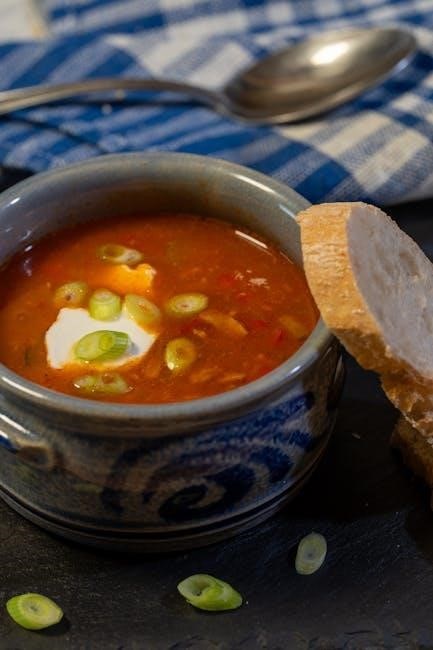Understanding Ham Shank
What is Ham Shank?
A ham shank is a cut of meat, usually bone-in, from the lower portion of the pig’s leg․ It’s often flavorful and can be a more economical option․ The shank cut is simpler to carve and it’s less likely to dry out, especially during cooking․
What is Ham Shank?
Ham shank, also known as the shank end of the ham, is a flavorful cut of pork taken from the lower portion of the pig’s leg․ Often sold bone-in, it offers a rich, savory taste that makes it a popular choice for holiday meals and hearty family dinners․ Compared to other ham cuts, the ham shank is less likely to dry out during cooking, making it a forgiving option for both novice and experienced cooks․ Its bone-in nature also contributes to a richer flavor profile, perfect for creating delicious stocks and soups after the meat has been enjoyed․
Buying Ham Shank
Ham shanks can be found at most grocery stores and butcher shops․ Consider purchasing from local farms or specialty meat markets for potentially higher-quality options․ You can order country ham shanks online as well, delivered to your door․
Where to Buy Ham Shank
Finding a ham shank is generally straightforward․ Most major grocery store chains will carry them, often in the meat section near the other pork products․ Butcher shops are another excellent source, as they may offer higher-quality or locally sourced options․ Some online retailers also sell ham shanks, offering convenience and potentially a wider selection․ Look for options from farms or specialty meat providers for unique flavors․ If you are looking for Cooks ham portion butt and shanks only, you will need to go to the shops․
Types of Ham Shank: Precooked vs․ Raw
When purchasing a ham shank, you’ll typically encounter two primary options: precooked and raw․ Precooked ham shanks are already fully cooked and require only reheating, making them a convenient choice․ Raw ham shanks, on the other hand, need to be fully cooked before consumption․ The cooking time and internal temperature will vary․ Some may be smoked to increase the flavor of the raw meat․ Always check the label to determine which kind you are purchasing․
Preparing Ham Shank for Cooking
Begin by removing all packaging from the ham shank, including any clear buttons on the bone․ Then, trim most of the excess fat from the ham, leaving a thin layer for flavor and moisture during cooking․
Removing Packaging and Excess Fat
Before cooking your ham shank, it’s essential to remove all packaging materials completely, including any plastic wrapping or absorbent pads․ A small, clear button might be present on the bone; ensure this is removed as well․ Next, assess the fat cap on the ham shank․ While some fat is desirable for flavor and moisture, excessive fat should be trimmed․ Use a sharp knife to carefully trim the fat cap, leaving approximately a quarter-inch layer․ This will allow the fat to render during cooking, basting the meat and adding richness, without resulting in an overly greasy final product․
Scoring the Fat Surface
After trimming the excess fat, scoring the remaining fat cap on the ham shank is a crucial step for both flavor and presentation․ Use a sharp knife to make shallow cuts in a diamond or crosshatch pattern across the fat surface․ Be careful not to cut into the meat itself․ Scoring allows rendered fat to escape during cooking, basting the ham and creating a beautiful, caramelized crust․ It also provides more surface area for glazes to adhere to, infusing the ham with flavor and resulting in a more visually appealing finished product․

Cooking Ham Shank in the Oven
Preheating the oven is crucial for even cooking․ Set your oven to 325°F (163°C)․ This moderate temperature ensures the ham cooks through without drying out․ Allow the oven to fully preheat before placing the ham inside․
Preheating the Oven
Before embarking on the culinary journey of baking your ham shank, preheating the oven is a pivotal step․ Set the oven temperature to 325°F (163°C), a moderate heat that allows the ham to cook evenly without becoming overly dry․ Allow ample time for the oven to reach the designated temperature․ This ensures that the ham cooks uniformly, resulting in a succulent and flavorful dish․ A fully preheated oven contributes significantly to achieving the desired texture and taste․ Patience during this preheating phase is key to a successful ham shank preparation․
Oven Temperature and Cooking Time
Maintain a consistent oven temperature of 325°F (163°C) throughout the cooking process․ As a general guideline, plan for approximately 15 to 20 minutes of cooking time per pound of ham shank․ For example, a 10-12 pound shank ham may require around 2-3 hours in the oven․ However, rely on a meat thermometer to accurately determine doneness․ Insert the thermometer into the thickest part of the ham, avoiding the bone, and ensure it reaches an internal temperature of 140°F (60°C)․ Adjust cooking time accordingly to achieve this target․

Cooking Ham Shank in a Roaster Oven
Cooking a ham shank in a roaster oven can be an easy way to achieve a juicy, flavorful result․ The key is to maintain a consistent temperature and moisture level․ Place the ham shank in the roaster oven, ensuring it’s elevated on a rack if possible․ Add about a cup of broth, juice, or water to the bottom of the roaster to create steam․ Cook at a moderate temperature, around 325°F (163°C), and monitor the internal temperature with a meat thermometer until it reaches 140°F (60°C)․
Cooking Smoked Ham Shank
Cooking a smoked ham shank involves enhancing its already delicious smoky flavor and ensuring it remains moist․ Begin by preheating your oven to 325°F (163°C)․ Place the smoked ham shank in a roasting pan with a cup of water or broth to prevent it from drying out․ Cover the pan tightly with foil and bake for approximately 15 minutes per pound, or until the internal temperature reaches 140°F (60°C)․ Consider adding a glaze during the last 30 minutes of cooking to further enhance the flavor․

Cooking Ham Shank in a Slow Cooker
Cooking ham shank in a slow cooker is a simple and effective method for achieving a tender and flavorful result․ Place the ham shank in the slow cooker, and add liquid such as water, broth, or even cola to cover the bottom․ Cook on low for approximately 6-8 hours, or until the ham is heated through․ You can apply a glaze during the last hour of cooking for added flavor․ This method is a great way to save energy compared to oven cooking․
Glazing Ham Shank
Glazing a ham shank adds a flavorful and attractive finish․ Apply the glaze during the last 30 minutes of cooking․ This allows the sugars to caramelize without burning․ Baste frequently for an even coating and rich flavor․
Glaze Recipes (Brown Sugar, Maple, Honey-Mustard)
Brown Sugar Glaze: Combine brown sugar with Dijon mustard․ This classic glaze offers a sweet and tangy flavor․ Maple Glaze: Mix maple syrup with a touch of Dijon mustard for a sweet, robust flavor․ Honey-Mustard Glaze: Blend honey, Dijon mustard, and a pinch of your favorite herbs for a balanced sweet and savory experience․ These glazes complement the ham’s natural smokiness, creating a delicious crust․ Each glaze brings a unique taste profile, enhancing your ham shank․
Applying the Glaze
Begin glazing the ham approximately 30 minutes before the end of the cooking time․ Remove the foil and brush the glaze evenly over the ham’s surface․ Return the ham to the oven and bake uncovered, basting occasionally with pan juices․ For a thicker glaze, apply multiple layers, allowing each layer to set before adding the next․ Consider turning up the oven heat to 425 degrees F for the last 30 minutes to caramelize the glaze, creating a beautiful, flavorful crust․
Checking for Doneness
To ensure your ham shank is properly cooked, use a meat thermometer․ Insert the thermometer into the thickest part of the ham, avoiding the bone, to get an accurate reading of the internal temperature․
Using a Meat Thermometer
The most reliable way to check if your ham shank is done is by using a meat thermometer․ Insert the thermometer into the thickest part of the ham, being careful not to touch the bone, as this can give you a false reading․ For a fully cooked ham, you’re looking for an internal temperature of 140°F (60°C)․ For partially cooked hams, aim for 150°F (66°C)․ This ensures the ham is heated through and safe to eat, without being overcooked and dry․ Always trust the thermometer!
Target Internal Temperature
Achieving the correct internal temperature is crucial for a safe and delicious ham shank․ If you’re cooking a fully cooked ham shank, your target internal temperature should be around 140°F (60°C)․ For a partially cooked ham, aim for an internal temperature of 145°F (63°C) to 150°F (66°C)․ Using a meat thermometer is essential to ensure accuracy․ Insert it into the thickest part of the ham, avoiding bone contact․ Reaching the target temperature guarantees the ham is heated through, safe to consume, and retains its optimal flavor and moisture․

Resting and Carving Ham Shank
Allowing the ham shank to rest before carving is crucial․ This allows the juices to redistribute, resulting in a more moist and flavorful final product․ Let it rest for 15-20 minutes before carving to maximize enjoyment․
Resting Time Before Carving
After roasting your ham shank, it’s tempting to carve right in, but patience is key․ Letting the ham rest for at least 15 to 20 minutes, or even longer, allows the internal juices to redistribute throughout the meat․ This resting period ensures that each slice is moist and flavorful, preventing the juices from running out and drying out the ham․ Cover loosely with foil during this time to keep it warm․ This step is crucial for a tender and delicious ham shank․ So, resist the urge to carve immediately, and let the ham rest for optimal results․
Carving Techniques
Carving a ham shank can seem daunting, but with the right technique, it’s manageable․ First, stabilize the ham on a cutting board․ Identify the bone and use a sharp knife to slice the meat parallel to the bone․ Work your way around the shank, releasing the slices․ If the ham is bone-in, you may need to make strategic cuts to remove the meat from the bone entirely․ Aim for even slices, and don’t be afraid to adjust your angle as needed․ Consider the shank cut of ham because it’s simpler to carve․
Serving and Using Leftovers
Ham shank is a versatile dish, great with eggs or salad․ Sliced, it elevates sandwiches and soups․ Serve with eggs for a morning breakfast․ Heat slices uncovered for 25 to 30 minutes․ Cooks ham is a great addition to any meal․
Serving Suggestions
Cooked ham is versatile and elevates various meals․ Serve it alongside eggs for a hearty breakfast․ Thinly sliced, it enhances salads, soups, and sandwiches․ For a warm dish, heat glazed ham uncovered for 25 to 30 minutes․ Consider pairing it with classic sides like scalloped potatoes, green bean casserole, or roasted vegetables․ A fruit chutney or mustard-based sauce complements the savory flavor of the ham․ Don’t forget a crusty bread for soaking up the delicious juices!
Using the Ham Bone for Stock
Don’t discard the ham bone after carving! It’s a treasure trove of flavor for making rich, savory stock․ Place the bone in a large pot, cover it with water, and add aromatics like onions, carrots, celery, and herbs․ Simmer for several hours to extract the maximum flavor․ Strain the stock and use it as a base for soups, stews, or sauces․ Ham stock adds depth and complexity to dishes like bean soup or split pea soup․ It can also be frozen for later use, providing a flavorful boost to your cooking whenever needed․
